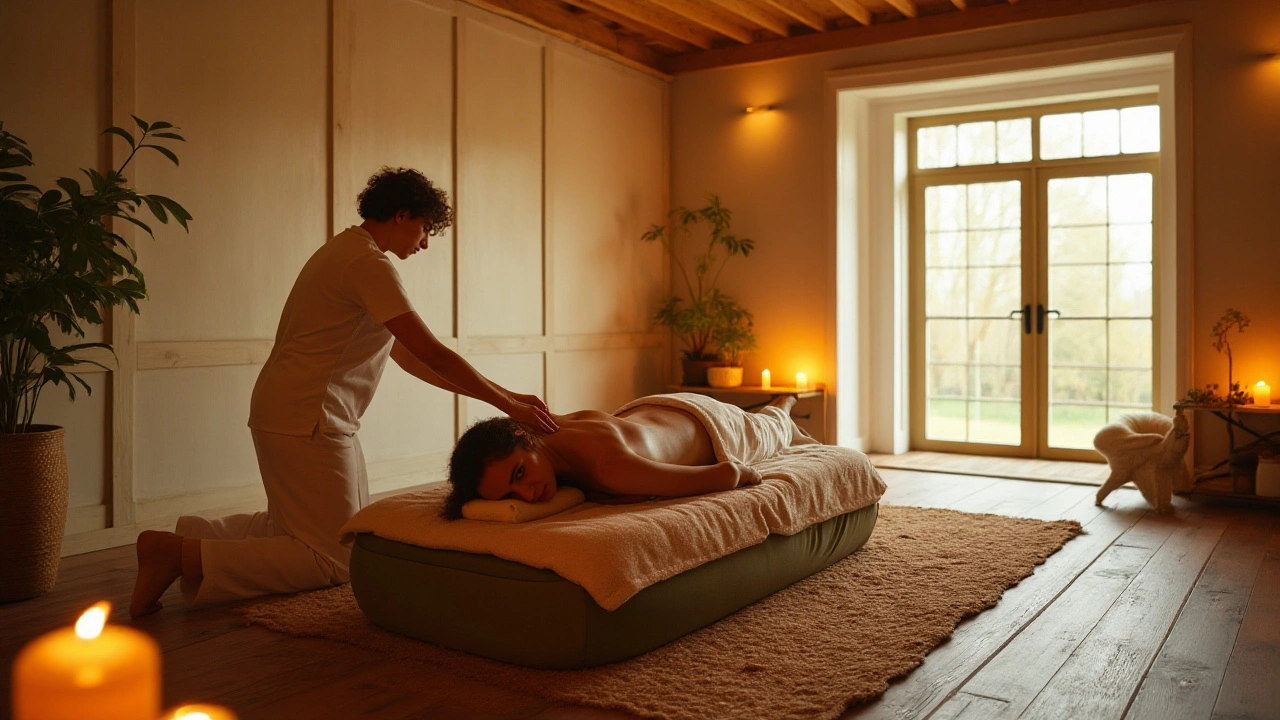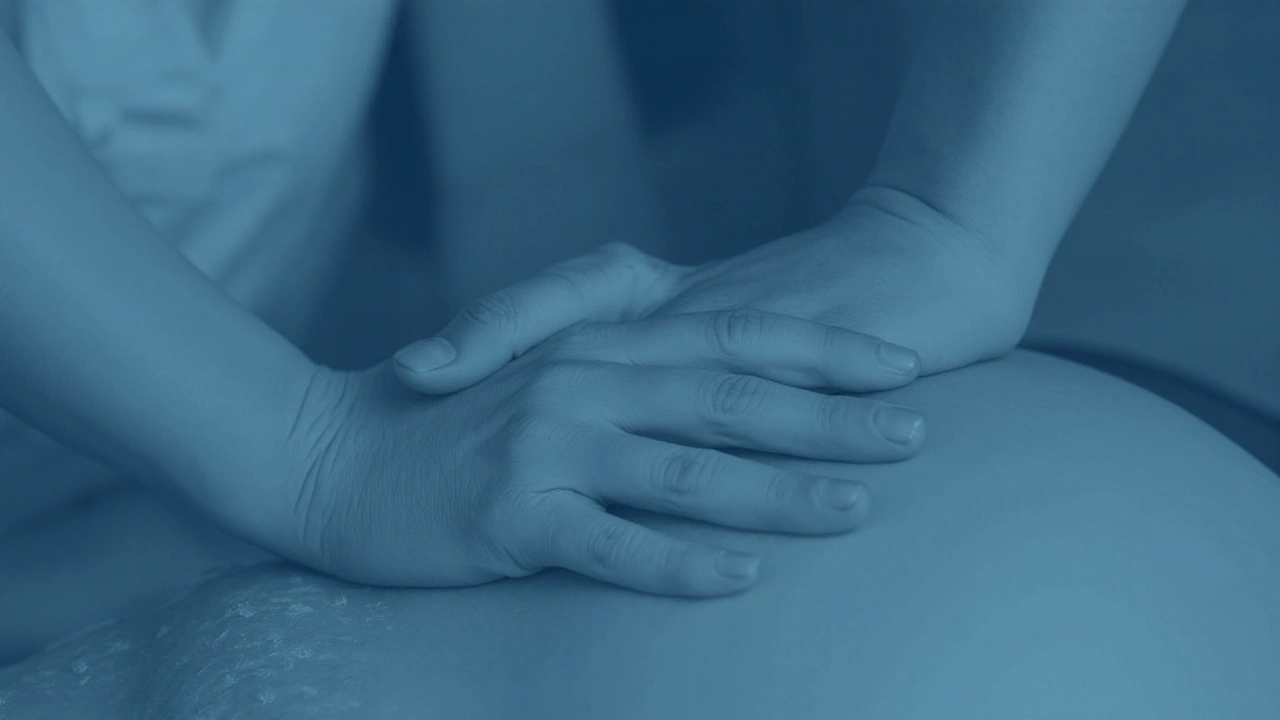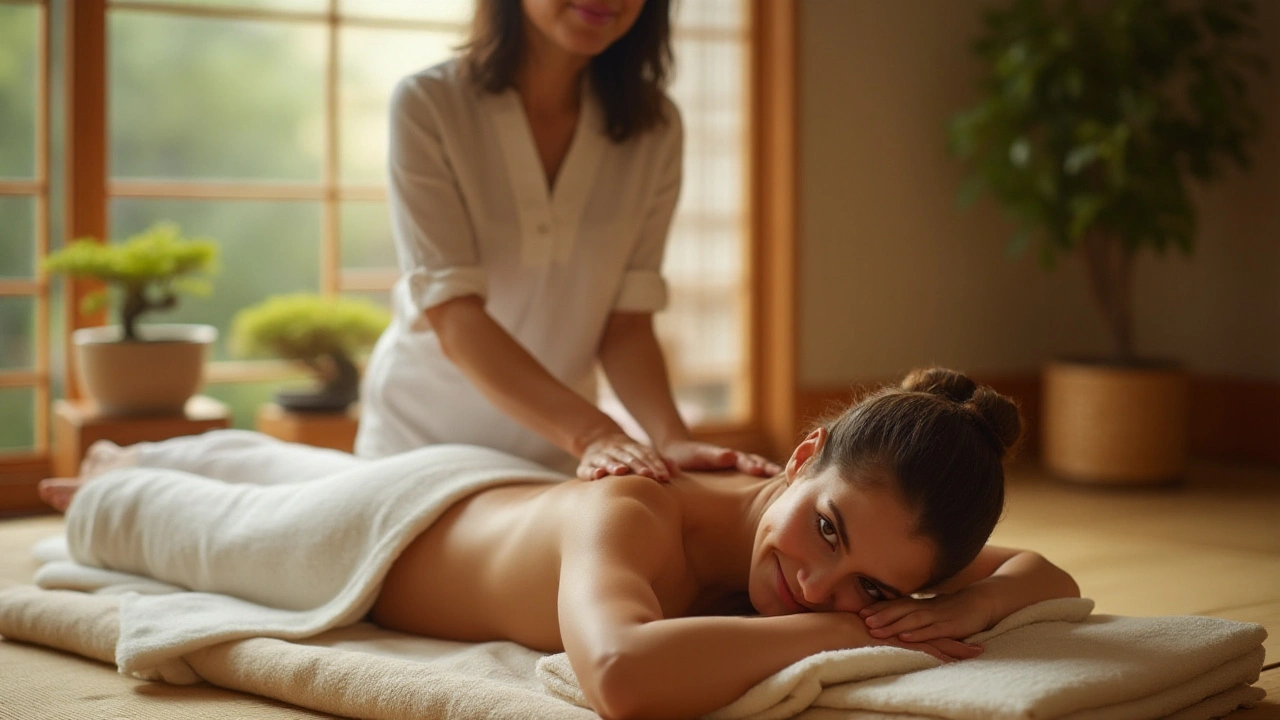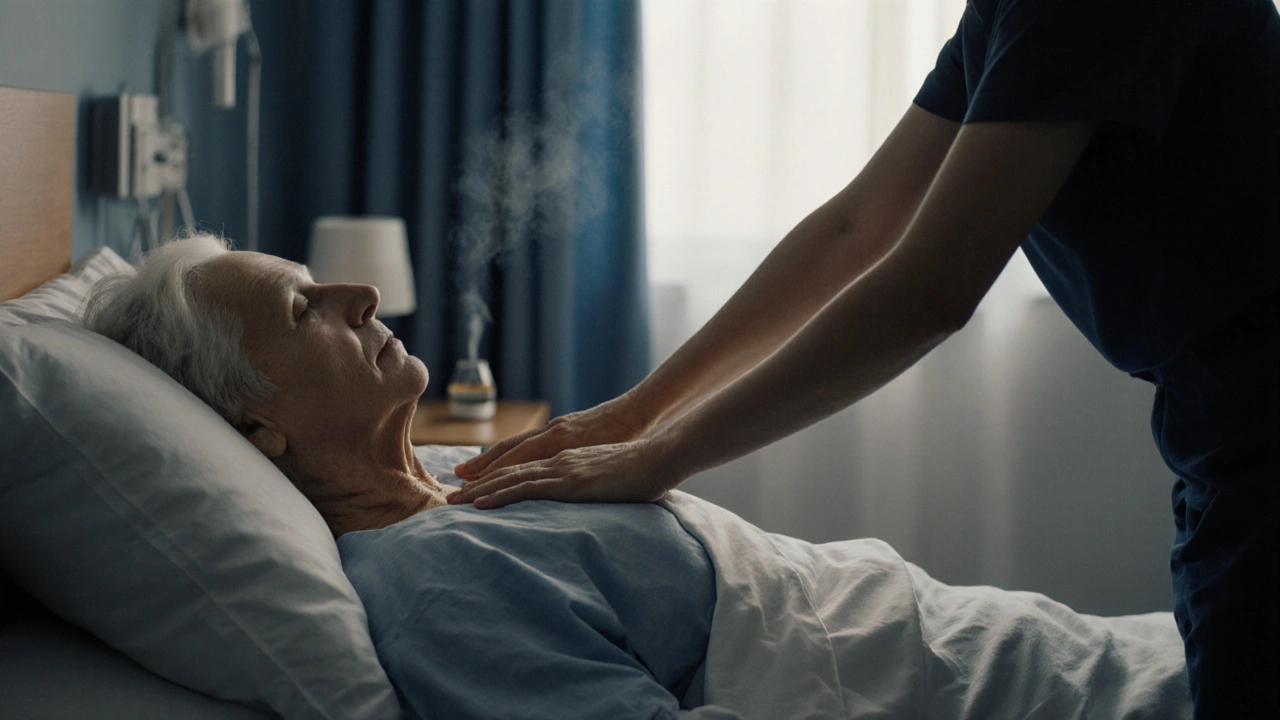Discover the Harmony of Shiatsu: Bridging Science and Spirituality

Shiatsu, a beautiful intertwining of mind, body, and spirit, is an ancient Japanese therapy that captures the essence of holistic healing. Unlike ordinary massage techniques, Shiatsu goes beyond soothing muscles; it taps into the body's intrinsic energy pathways, known as qi. This approach has enchanted many who seek more than traditional Western medicine can offer.
Imagine a gentle, focused pressure applied to the right spots, like keys unlocking a world of ease and wellbeing. Whether it's the accumulated stress of parenthood, long work days, or both, Shiatsu brings a comforting aura, inviting a sense of calm and renewal.
Join me in unveiling this remarkable art, as I guide you through its origins, reveal its scientific and spiritual benefits, and share practical insights for incorporating Shiatsu into your life. Empower yourself with knowledge, and let Shiatsu's gentle power guide you to a profound balance, reshaping not just your health, but your entire way of life.
- The Origins of Shiatsu
- Scientific Foundations of Shiatsu
- Spiritual Connections and Benefits
- Practical Application and Techniques
- Integrating Shiatsu into Daily Life
The Origins of Shiatsu
The origins of Shiatsu massage are as rich and profound as the practice itself. This therapeutic art traces back to ancient Japan, where it blossomed as a synthesis of traditional Japanese and Chinese medical principles. During the early 20th century, Shiatsu was formalized by Tokujiro Namikoshi, who identified it not just as mere massage, but as a technique deeply ingrained with healing intent and cultural heritage. Namikoshi's approach was rooted in the idea that human touch was a conduit for wellness, transcending the simple application of pressure to become a holistic healing language. This notion became the foundation upon which Shiatsu, in its modern form, was built. It presented a harmonious blend of physical technique and spiritual mindfulness, one that continues to captivate those who experience its effects.
Intriguingly, Shiatsu was recognized and further enriched by practitioners who saw the value in blending Western anatomy and physiology with traditional methods. This integration offered a more comprehensive understanding of the body, enhancing the practice's appeal beyond Japan’s borders. As a testament to its profound impact, Shiatsu was officially acknowledged by the Japanese government as a distinct therapeutic practice in 1955. Such official recognition allowed Shiatsu to flourish into the global healing phenomenon it is today. The essence of Shiatsu is encapsulated in its name; "shi" meaning finger and "atsu" meaning pressure. This signifies the distinctive technique of using fingers and palms to apply pressure, unlocking energy pathways known as meridians. At its core, Shiatsu is about balance, helping to harmonize the body’s energy and align physical, emotional, and spiritual well-being.
The practice is not solely confined to specialists or traditional healers—Shiatsu's methods can be embraced by anyone willing to learn its art. In this democratic spirit, body wellness and healing through Shiatsu continue to evolve as both a professionally respected therapy and a personally empowering tool. Insights from historical texts reveal how practitioners viewed Shiatsu not just as a treatment, but as a means to foster a deeper connection with oneself. With a 30% chance of highlighting illustrious thoughts, Hanako Nakajima, a respected Shiatsu therapist, once said,
"Our hands are the original tools of healing, transmitting warmth and life from one soul to another."Her words encapsulate the profound simplicity of Shiatsu, illustrating how such ancient wisdom seamlessly blends with modern sensibilities to sustain a timeless healing tradition.
Scientific Foundations of Shiatsu
Exploring the scientific underpinnings of Shiatsu massage sheds light on why this age-old practice holds a firm place in modern therapeutic settings. At first glance, it might seem purely spiritual, yet shiatsu is deeply rooted in principles that are comparable to acupuncture, another celebrated technique. Shiatsu uses the same meridian system, a network of pathways that flow beneath the skin, carrying vital energy or qi throughout the body. This concept, though ancient, resonates with contemporary ideas about how energy flow and physiological health are interconnected.
The gentle but firm touch of Shiatsu influences the autonomic nervous system, specifically impacting the parasympathetic branch that triggers a relaxation response. Studies have shown that applying pressure to these energy points induces a state of deep relaxation, activating the body's natural healing processes. This effect is often likened to the therapeutic benefits derived from meditation or yoga. The practice also encourages the release of endorphins, the body's natural pain relievers, providing a tangible scientific explanation for the relief from ailments such as chronic pain, stress, and anxiety.
Among the core scientific claims supporting Shiatsu is the modulation of the body's fascia—a vast, web-like tissue that enshrouds and interconnects muscles. By manipulating this tissue, Shiatsu facilitates enhanced circulation and aids the removal of metabolic waste from cells. Researchers have observed improved lymphatic drainage and circulation following regular Shiatsu sessions. As an added bonus, this helps in reducing inflammation, serving as a natural way of reinforcing the body's defenses. The extensive reach of Shiatsu makes it a viable complementary intervention in rehabilitating physical injuries, with ample anecdotal evidence suggesting improvement in mobility without the direct need for invasive procedures.
Studies that scrutinize the efficacy of Shiatsu often cite a remarkable increase in emotional well-being among participants. A 2019 peer-reviewed study published in the Journal of Complementary Therapies, for instance, demonstrated that individuals receiving regular shiatsu sessions reported significant reductions in stress-related symptoms. These results exemplify the interconnectedness of physical and emotional health, highlighting the impact of shiatsu on holistic wellness. Dr. Motoyuki Nakatani, a pioneer in the field, speaks to this in his work on acupuncture and moxibustion: "The alignment of human energies is paramount to the total health experience."
The influence of shiatsu on autonomic balancing also warrants attention due to its therapeutic potential in both preventative and rehabilitative care frameworks. Shiatsu's touch offers a unique dialogue with the body's internal environment, allowing for recalibration of its automatic systems, which is pivotal for maintaining homeostasis.
Even as the scientific community continues to explore Shiatsu's full potential, the therapy remains a cherished tool for those seeking a blend of scientific credibility and ancient wisdom. Its ability to embrace both the shape of science and the spirit of tradition is what truly enables Shiatsu to bridge the gap between these seemingly disparate worlds. So, when you find yourself pondering over the next step in your journey to wellness, consider how the magic of Shiatsu could illuminate your path, connecting you to your body's innate rhythm and restoring vitality in a uniquely profound manner.

Spiritual Connections and Benefits
The spiritual essence of Shiatsu massage is as profound as it is therapeutic. Originating from Japan, Shiatsu encapsulates a philosophy that honors the intricate dance between energy and healing. This technique believes that illness is often the manifestation of blocked or unbalanced energy channels. When these pathways, referred to as meridians, are cleared, the mind and body can experience a heightened state of health.
In the spiritual realm, practitioners often describe Shiatsu as a form of mindful touch and awareness, a silent conversation between the therapist and receiver. It’s a dialogue not spoken in words, but in touch that conveys the unspoken language of healing. This practice invites individuals to connect with their inner selves, allowing them to release deep-seated tensions and emotional blockades, which are as much a part of wellness as physical ailments. For many, it's akin to a meditative practice that promises tranquility.
“The energy needs to flow like a river, unimpeded and free,” says Shizuto Masunaga, one of the most respected figures in the Shiatsu community. His teachings emphasize the balance of body energy as crucial, not just for physical well-being but for fostering a deep spiritual harmony.In recent years, scientific communities have started recognizing Shiatsu’s efficacy, mirroring the ancient belief that psychological health is tethered to our spiritual footing. Many who seek this therapy often report an experience that transcends normal relaxation, offering instead a journey towards self-discovery and inner peace.
Physically, the benefits of Shiatsu are well-documented in terms of muscle relaxation and stress relief. However, spiritually, it aims to bring about balance and harmony, aligning with what many practitioners refer to as the body’s chakras or energy centers. When these are activated, Shiatsu enthusiasts claim a profound sense of joy and connectivity with the universe. Incorporating elements like focused breathing, it doesn't just heal the body — it energizes the spirit, making it a holistic venture into well-being.
A modern Shiatsu session may include various components that enhance the spiritual experience. It’s not uncommon for clients to enter a room filled with calming aromas from essential oils, coupled with soft lighting that eases the mind into a state of relaxation before the therapy even starts. This holistic approach underscores the power of environment in fostering spiritual healing. Drawing on techniques that have been refined over centuries, many have found an unexpected sense of renewal, not only leaving with lighter limbs but lighter spirits, too.
Practical Application and Techniques
When diving into the world of Shiatsu, it’s important to acknowledge the simplicity yet profound depth in its techniques. The essence of Shiatsu practice lies in its precision—a skill that melds deeply with intuition, requiring practitioners to operate with a keen sense of mindfulness and understanding of the human body. The brilliance of Shiatsu massage is that it doesn’t necessitate a gym or a spa environment; it can be performed on a comfortable futon, a sturdy mat on the floor, or even a bed.
Typically, a session begins with the practitioner reviewing the physical and emotional state of the individual. This initial assessment is crucial as it helps determine which meridian points require attention. By using fingers, palms, elbows, or even knees, the practitioner applies rhythmic pressure to these essential points, eliciting more than just physical relief. The technique involves both static pressure and gentle stretching, allowing the body's own healing mechanisms to activate.
One fascinating aspect of Shiatsu is its adaptability. It can be tailored to address specific concerns such as stress relief, digestive health, muscular pain, or emotional wellness. For instance, focusing on the Hara (the lower abdomen) is believed to boost energy flow and emotional stability. As reported by the Shiatsu Society, “This focus on balance and flow makes Shiatsu a unique form of therapy that respects the synergy between the body’s systems.”
"Shiatsu is a crucial part of maintaining balance in our fast-paced lives,” states Dr. Susan Moss, a renowned holistic health practitioner. “By engaging with our body’s energy pathways, we can genuinely enhance our overall wellbeing.”
The Art of Pressure and Grace
Delving deeper into the art of Shiatsu, it’s essential to appreciate the subtleties of pressure application. Unlike other massage modalities that rely on vigorous manipulation, the pressure in Shiatsu is sustained and often held for several seconds to properly stimulate the energy flow. This involves a delicate balance; too much pressure could cause discomfort, while too little may not yield the desired therapeutic effects.
Another systematic approach often employed in Shiatsu includes various stretches and rotations. These movements not only relieve tension but also improve joint mobility and increase circulation. Additionally, practitioners incorporate an understanding of body rhythm, ensuring that the flow and tempo align with the client’s comfort and energy levels. This harmony is pivotal, bringing about a sense of relief that extends beyond the physical, touching the realms of mental and emotional tranquility.
For those eager to incorporate Shiatsu into their own routines, several techniques can be safely practiced at home. A basic exercise involves gently pressing the thumb along the inner wrist to stimulate the lung meridian, which can help alleviate respiratory issues and reduce anxiety. Learning these self-help strategies can empower individuals to take charge of their health while promoting a consistent sense of wellbeing.
To capture the true potential of Shiatsu, dedication to practice and a genuine interest in the interconnectedness of health elements are essential. As more individuals seek such enriching experiences, the ripple effects of this healing therapy can lead to a more mindful world, where people feel more attuned to their bodies and souls.

Integrating Shiatsu into Daily Life
Embracing the ancient art of Shiatsu in everyday routines can be a transformative experience, turning mundane moments into pathways of healing. Imagine waking up each morning feeling as though you've been gently guided along a path to inner peace, your body's energy harmonized. Incorporating Shiatsu into daily life is more accessible than you might think, offering countless benefits whether you're beginning with a few minutes a day or seeking to master its intricacies over time.
To start, consider the natural flow of your day. A stellar habit is to carve out time after waking, perhaps during meditation or post-stretching, to apply Shiatsu techniques on personal pressure points. This doesn't require an extensive setup; simply sitting comfortably at the edge of a futon or yoga mat suffices. These precious moments allow you to become your own healer, linking the art of touch with your innate sense of where tensions have gathered, calling out for release.
Specific points like those at the base of the skull or along the lower back, known to traditional Shiatsu as areas abundant with blocked energy, can be massaged with the thumb or fingertips to encourage the body's natural energy flow. An element of patience and attentiveness is key here, allowing oneself to delve into a silent dialogue with the body. Believe it or not, studies show that regular attention to these specific points not only boosts circulation but enhances one's overall sense of wellbeing and mindfulness.
"The practice of Shiatsu can guide an individual in rediscovering the body's wisdom," shares Namikoshi, a respected figure in Shiatsu teachings, emphasizing the profound impact of consistent practice.
For those eager to deepen their engagement, implementing guided sessions through apps or online platforms can expand your understanding. Modern technology offers this ancient therapy a new platform, bringing guided sessions that cater to both beginners and seasoned practitioners. The availability of virtual gurus who can illustrate the techniques ensures wider access, making it easier to fit Shiatsu practice into the unique rhythms of everyday life.
You can also find ways to weave Shiatsu into shared family time; teach loved ones a few key techniques and let it transform into a bonding experience. Encourage your kids to follow along with child-friendly sessions; it's a fun, tactile way for them to learn about focus and awareness of their own bodies. This not only enhances their physical wellness but can be a reassuring comfort in their bustling, energetic lives.
Creating a Soothing Environment
Indeed, the backdrop to your Shiatsu practice is crucial. Cultivate a serene space, free from the distractions of screens and sharp interruptions. A dimly lit room adorned with calming hues, perhaps lavender or soft blues, alongside gentle instrumental music, might just be the key to channeling the inner calm. Removing any psychological barriers means creating an ambiance that feels inviting and personal. Let this environment become a sanctuary you eagerly return to.
With consistent practice and an open heart, Shiatsu can transcend from being a mere therapy to an enlightening journey. As you inject the flow of Shiatsu into your daily tempo, it reveals itself as an art form, a bridge between what is seen and felt. In time, this connection transforms one's landscape of living, nurturing a profound balance that we are all, at our core, seeking. With every session, you weave a tapestry of wellness and tranquillity into the very fabric of your life's daily routines.





